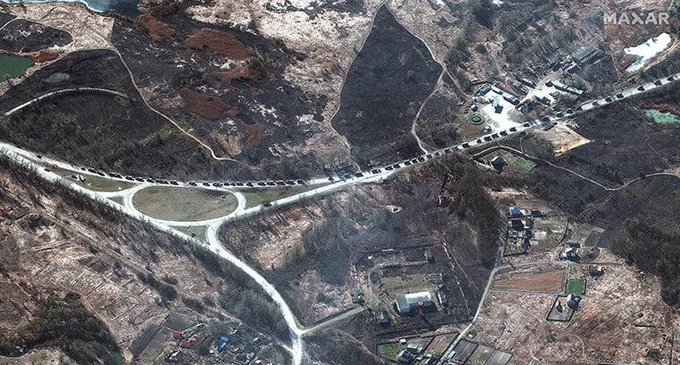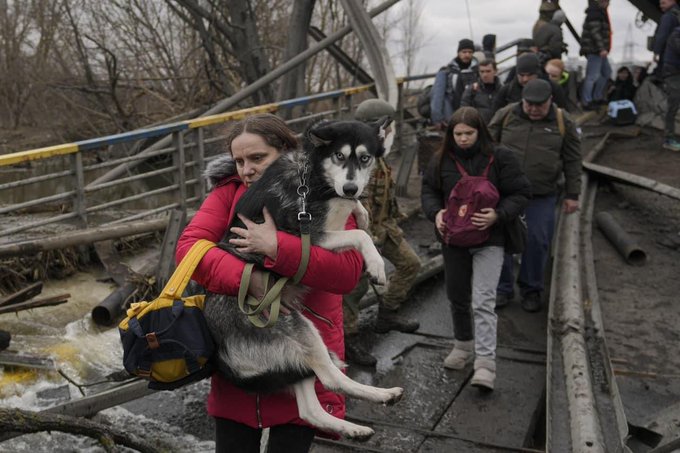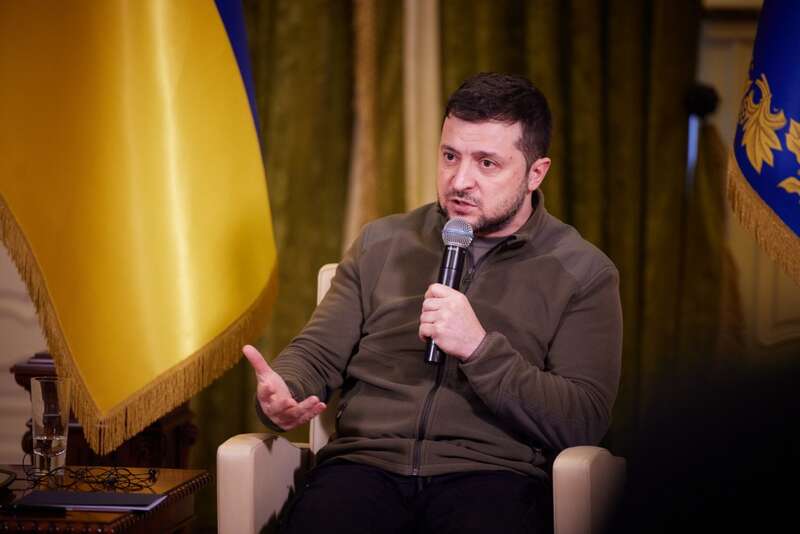Massive offensive on Kyiv on its way
Russia is getting ready to relaunch a massive offensive on Kyiv, the war’s main goal. Experts believe that seizing the capital might be too difficult for the Russians. It's more likely that they will try and establish a blockade amid relentless shelling and airstrikes in order to force Kyiv into surrendering, writes defense reporter Illia Ponomarenko at The Kyiv Independent.
 Approximate Russian (red) and Ukrainian (blue) positions and axes of attack in the Battle of Kyiv as of March 12, 2022 (The Kyiv Independent)
Approximate Russian (red) and Ukrainian (blue) positions and axes of attack in the Battle of Kyiv as of March 12, 2022 (The Kyiv Independent)
by Illia Ponomarenko
Despite a very complicated situation with many of its main axes of attack throughout Ukraine, Russia keeps throwing more military power west and east of Kyiv, in a bid to possibly surround and penetrate the city. Satellite images issued by U.S. company Maxar reveal Russia’s very recent activity close to the Hostomel Airfield, including armored units and towed artillery.
'Russia is likely seeking to reset and re-posture its forces for renewed offensive activity in the coming days,' as the British Defense Ministry said in its March 11 intelligence update. 'This will probably include operations against the capital, Kyiv.' As the expert community believes, Kyiv should brace itself for a hard defense within short notice, potentially for Russian attempts to impose a full blockade and trigger a humanitarian disaster to force the Ukrainian leadership into a deal.
Nonetheless, as the situation suggests, Russian prospects look increasingly grim as well. With Russia’s failed attempts to seize Kyiv in a blitz attack, along with steady defense efforts, the capital city has all chances to grind over and bleed dry invading forces in fierce urban combat, effectively precipitating a strategic victory over Russia.
Russia’s scarce progress
As in any of the key areas, such as Mykolaiv, or Kharkiv, or Chernihiv, Russia has demonstrated very little progress in the battle for Kyiv over the last few days. A series of fierce attacks before March 8-9 ended up with Russia gaining a foothold northwest of Kyiv, in the satellite cities of Irpin, Bucha, and Hostomel, a key junction on the E373 road, more commonly known as the Warsaw Highway.
Along with the P02 road to the north, this has become the Russian military’s vital throughway between the Kyiv metropolitan area and Belarus via the Chornobyl Exclusion Zone. At huge costs, Russia has formally secured this passage for supplies and fresh troops. However, as multiple evidence suggests, the narrow corridor is still prone to extreme logistics issues, which end up causing fuel and food shortages among Russian forces advancing towards Kyiv.
Very illustrative was the situation regarding the ill-fated Russian military convoy stretching 64 kilometers along the highway northwest of Kyiv. For many days, numerous satellite pictures showed the convoy, basically, a giant traffic jam, standing still, very likely due to fuel shortage and poor technical condition of vehicles that effectively stalled the movement.
 Russian military convoy near Kyiv has been relocated an dispersed. Photo Maxar
Russian military convoy near Kyiv has been relocated an dispersed. Photo Maxar
But according to the latest observations, the giant convoy has largely dispersed, likely redistributed among multiple Russian units in the area. After gaining a foothold in parts of Hostomel, Bucha, and Irpin, Russia also demonstrated very limited success trying to advance further south to the defunct E40 road connecting Kyiv and Zhytomyr.
According to Ukraine’s General Staff, this group of Russian forces is most probably poised to partially surround Kyiv from the west and cut the capital city off from supplies. On March 8, the Institute For the Study of War (ISW), a Washington D.C.-based think tank, said Russian forces were concentrating on a possible assault against the capital in the coming 24 to 96 hours.
Nonetheless, amid extremely slow progress due to logistical issues and a strong Ukrainian defense, Russia has probably decided to take a breathing spell in operations and agreed on civilian evacuation from Bucha, Irpin, Hostomel, and Borodyanka, the cities that have been largely ruined.
As the Ukrainian military suggests, Russian forces in many ways used this lull to try and re-array west of Kyiv and possibly get its logistics issues resolved for an effective onslaught. The last few days in the area have been relatively calm, although the warring parties have had sporadic clashes. Russia is also investing a lot of effort into trying to gain a foothold east of Kyiv, particularly the Brovary area. But this axis has proved even less successful.
Two key cities not controlles by Russia
Similarly to the Dnipro west bank, Russia is also confined to a few key highways leading northeast to Russia and Belarus, particularly the E-95, M-02, and H-07 roads. And the problem for Russia is that it has so far failed to seize or effectively block two key cities on its way to Kyiv, namely Chernihiv and Sumy, both of which continue offering fierce resistance since day one of the invasion and inflicting severe enemy casualties. Without the stiff control of either of the two cities, along with ensuring safe communications along the highways, gaining ground east of Kyiv is also extremely problematic.
As a result, Russia has no effective control over the vast territories between Kyiv and Chernihiv or Sumy, where Ukrainian regular military and territorial defense forces are practicing hit-and-run tactics. 'Sending large military forces to Kyiv from the north means long convoys moving along roads in the forest,' says Andriy Zagorodnyuk, former Ukraine’s defense minister and the chairman of the Kyiv-based Center for Defense Strategies.
'Convoys are very vulnerable in such a terrain. One needs to just target the convoy head, and the whole convoy effectively stops. And then it gets decimated. And this is what we see on a constant basis. The local geography is not on the invader’s side.'
 Inhabitants of Irpin, near Kyiv, are being evacuated after their town was shelled and isolated for two weeks. Photo from twitter
Inhabitants of Irpin, near Kyiv, are being evacuated after their town was shelled and isolated for two weeks. Photo from twitter
Day after day, the Ukrainian military and local social media users indicate multiple pieces of evidence of Russia’s massive loss of manpower and hardware in combat, especially in Chernihiv, Sumy, and Kyiv regions. As one of the latest developments, a Russian battalion tactical group, part of the 90th Armored Division’s 6th Regiment, sustained severe losses close to Brovary on March 10. According to Ukrainian statements, most of the regiment’s personnel, along with the commanding officer Colonel Andrey Zakharov, were killed in action. The division’s advancing groups had to retreat and stay on the defensive.
The Ukrainian victory likely further disrupted Russian efforts to set conditions for offensive operations east of Kyiv, as the Institute For the Study of War commented on the engagement. 'The episodic, limited, and largely unsuccessful Russian offensive operations around Kyiv increasingly support the Ukrainian General Staff’s repeated assessments that Russia lacks the combat power near the capital to launch successful offensive operations on a large scale,' the think tank said on March 10.
Besides, the ISW added, Ukrainian air force and air defense operations continue to hinder Russian maneuvers on the ground by likely limiting Russian close air support and also exposing Russian mechanized forces to Ukrainian air and artillery attacks. This suggestion was clearly illustrated by the March 10 engagement at Brovary, where the advancing Russian armored convoy moving concentrated on a highway was spotted and then decimated by intense and dense Ukrainian artillery and tank strikes.
Moreover, according to the ISW conclusions, the likelihood is increasing that Ukrainian forces could fight the Russian forces advancing to take Kyiv to a standstill, eventually. Logistics and organization issues, as well as poor morale and inadequate planning, have already cost it the swift victory it had evidently hoped for on Feb. 24.
'There are as yet no indications that the Russian military is reorganizing, reforming, learning lessons, or taking other measures that would lead to a sudden change in the pace or success of its operations,' the ISW also said on March 10. 'Although the numerical disparities between Russia and Ukraine leave open the possibility that Moscow will be able to restore rapid mobility or effective urban warfare to the battlefield.'
Blockade
The expert community has a consensus that Russia’s chances of seizing Kyiv are at least questionable, given the general performance to date. The blitzkrieg plan that would see the Ukrainian leadership in Kyiv being captured and forced into a deal within days has ultimately failed.
 The Russian blitzkrieg failed. President Zelensky gives a press conference in his office on March 12. Photo president.gov.ua
The Russian blitzkrieg failed. President Zelensky gives a press conference in his office on March 12. Photo president.gov.ua
Nonetheless, all sources suggest a concentration of Russian forces near Kyiv, despite seemingly unfavorable terms on the ground. 'The Kyiv axis is among their top priorities,' says Ruslan Leviev of the Conflict Intelligence Team, an online investigation group checking Russia’s military activity. 'As we believe, Russians may acknowledge the fact that at some point they will have to seek talks and offer a deal. So they need the strongest leverage they can get for the talks, which is the siege of Kyiv and a humanitarian disaster in the city.'
The Russian perspective of encircling Kyiv does not seem promising, given the mission’s complexity, the group believes. But even in case of an uneven success, Russia will unlikely resolve to try and break through the city defenses. It is much more likely that Russians will try and establish a blockade amid relentless shelling and airstrikes. Such tactics of forcing cities into surrendering via total terror have so far barely worked against Mariupol, Sumy, and especially Kharkiv, which carry on with their fierce resistance despite massive destruction and loss of life.
Kyiv, being a very large and well-fortified city, is an incomparably more difficult target for a Russian blockade, let alone an all-out assault, as experts believe. 'Assaulting Kyiv in this situation would a stupid thing to do,' says former defense minister and chairman of the Kyiv-based Center for Defense Strategies Zagorodnyuk.
'But we have already seen them doing stupid things — so we should not rule this out.'
We republished this article from The Kyiv Independent in a slightly shortened fashion
No comments:
Post a Comment